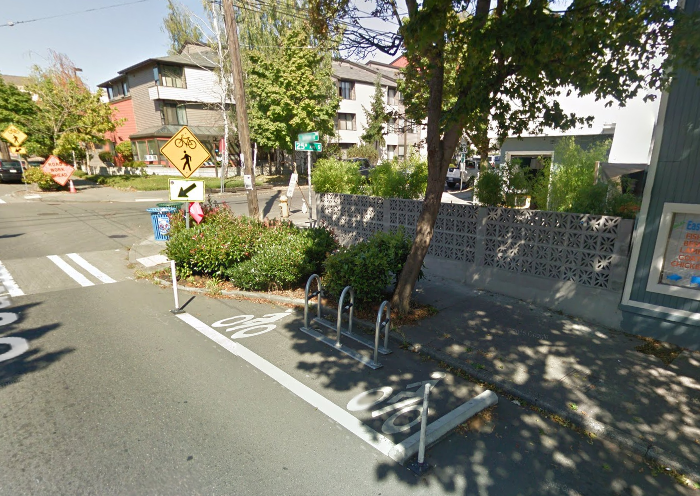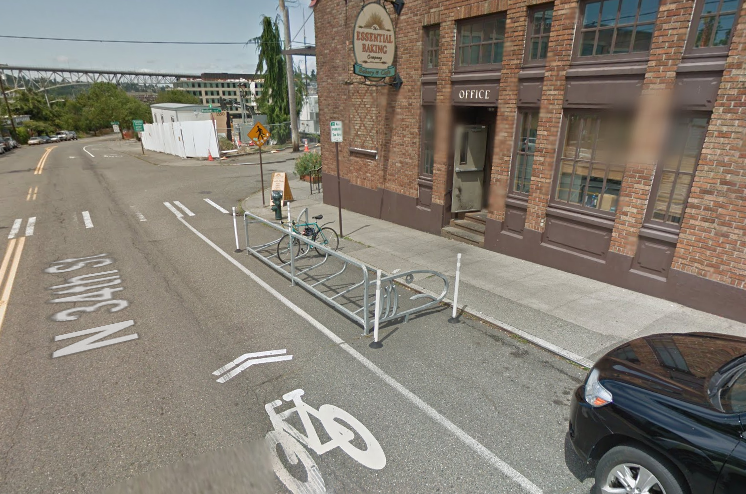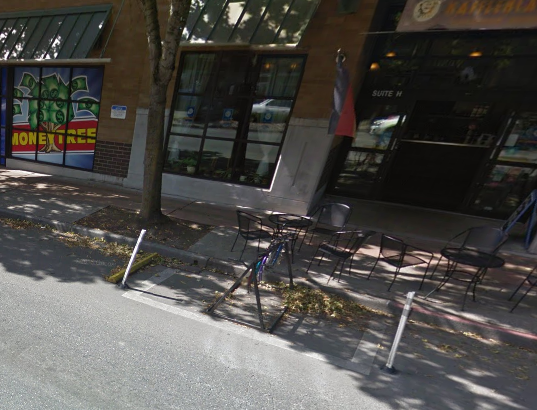Have you ever seen bike corrals appear in the curb area behind a stop sign and wondered why there? The Seattle Department of Transportation (SDOT) has a robust bike parking program dedicated to building these kinds of facilities throughout the city. And soon, you’ll be seeing a lot more of them.
SDOT has a good chunk of change to spend on bike parking in the coming years. The Move Seattle levy passed by voters last year promises to put $7 million into new bike parking infrastructure. SDOT says that could translate to some 1,500 new bicycle parking spots in the next nine years with a portion of that funding to also help maintain existing assets on the ground. But that doesn’t mean all of it will go toward that. Due to the flexible language in the levy, some of that could be pushed to other walking and biking spot improvements.
The City uses many different types of bike parking facilities depending upon the need and location. To give you a flavor for what those might be, here are a few:
- Rail-racks;
- V-racks;
- Ring racks;
- Inverted U-racks;
- Bike posts; and
- Variations thereof.
On-street bike corrals are just another tool in the bike storage toolbox, but they also happen to be a very pragmatic solution for three primary reasons:
- They can reduce the need to put bike storage on sidewalks;
- They can provide high storage capacity for bikes; and
- They can be strategically located in areas that couldn’t otherwise be used.
On-street bike corrals are very useful in areas with high foot traffic. That’s because they don’t have to be placed on the sidewalk, freeing up what is otherwise fairly limited real estate for people walking. SDOT locates bike corrals on-street within the clear zone area behind a stop sign. The standard clear zone distance is 20 feet, but SDOT also designates clear zones up to 30 feet, depending upon intersection design factors. This area is perfect for bike corrals because motorized vehicles aren’t permitted to park within the clear zone anyway. The low-profile nature of bikes makes them almost completely transparent from the perspective of a motorist approaching an intersection. Thus, the clear zone remains effectively clear despite the bike corral, stored bikes, and extra safety markings.
When SDOT can’t install a bike corral in the no-parking area near an intersection, staff will look into alternatives locations. Mid-block and sidewalk spaces are typically next on the list. SDOT tends to see sidewalk space as preferable to a mid-block on-street location, but staff does consider the pedestrian experience and other aspects of sidewalk use when looking at sidewalk locations. If those factors weigh higher on the scales, SDOT will place a bike corral mid-block on the street.



On-street bike corrals give a good bang for the buck with the average corral coming in at $2,600 for installation. SDOT uses several types of bike corrals, but the newer ones being installed tend to be three- or six-stall loop racks allowing for capacity of up to a dozen bikes. These bike corrals are anchored directly into the pavement using a pair of common pads that tie the loop racks together. SDOT also uses on-street marking–with cutesy bicyclist figures, flexible posts, and wheel stops to define and protect the bike corral area. The overall design appears to be fairly effective at providing a safe and easy-to-access space for people to store their bikes.
The standard approach to bicycle parking could be changing with an update to the Right-Of-Way Manual this fall, but the current language outlines the following design parameters:
On-street bicycle racks: Racks must have the following characteristics:
are intuitive to use correctly;
have a no-maintenance finish that won’t chip, peel, or rust. Galvanized steel finishes are preferred;
support the frame of the bicycle;
allow a u-style lock to secure one of the wheels and the frame to the rack;
allow removal of the front wheel and locking it with the rear wheel and frame to the rack;
have a minimum height of 2.5 feet so it is not a tripping hazard;
are installed as close to, without being directly in front of, the main entrance(s) of a building or site; and
have adequate clearance from driveways, curb ramps, transit loading areas and immediately adjacent to shelters, and utility poles.

So far, SDOT has installed about 90 on-street bike corrals throughout the city. Businesses and community organizations will often request installation of bike parking, which helps the City identify where local need is. On occasion, the City has shared costs with an external partner for installation of bicycle racks, but this has typically been limited to very unique designs. A great example is Kaffeeklatsch which insisted on installing a movable bike rack with individual racks built from bike frames. For quite some time, the bike rack was relegated to the sidewalk, but SDOT eventually formalized a street space mid-block in front of the café.
We talk a lot about safe streets. One of the big ancillary benefits by installing on-street bike corrals is that they can help tighten up streets and get people to be more present in the roadway. At intersections, this can make crossing a street easier for a pedestrian because no one driving can move to the far right of the roadway near it–crossings become shorter. Permanent street furniture and people congregating near the edge of the roadway generally makes people driving more aware of their surroundings, naturally responding with slower speeds and better road behavior–a win-win for all.
In a city with a growing share of people walking and biking, putting resources into installing high capacity bike storage facilities in otherwise unusable street space is a wise choice.
Stephen is a professional urban planner in Puget Sound with a passion for sustainable, livable, and diverse cities. He is especially interested in how policies, regulations, and programs can promote positive outcomes for communities. With stints in great cities like Bellingham and Cork, Stephen currently lives in Seattle. He primarily covers land use and transportation issues and has been with The Urbanist since 2014.



